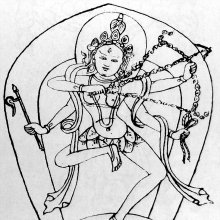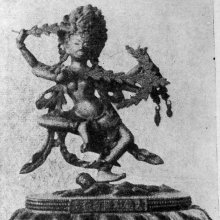Shuklakurukulla, Śuklakurukullā, Shukla-kurukulla: 1 definition
Introduction:
Shuklakurukulla means something in Buddhism, Pali. If you want to know the exact meaning, history, etymology or English translation of this term then check out the descriptions on this page. Add your comment or reference to a book if you want to contribute to this summary article.
The Sanskrit term Śuklakurukullā can be transliterated into English as Suklakurukulla or Shuklakurukulla, using the IAST transliteration scheme (?).
Images (photo gallery)
In Buddhism
Tibetan Buddhism (Vajrayana or tantric Buddhism)
Source: archive.org: The Indian Buddhist IconographyŚuklakurukullā (शुक्लकुरुकुल्ला) refers to one of the names of Kurukullā: one of the various (female) emanations of Amitābha having their Sādhana described in the 5th-century Sādhanamālā (a collection of sādhana texts that contain detailed instructions for rituals).—Her Colour is white; her Symbols are the rosary and the bowl of lotus; her Vāhana is the animal; hert Āsana is the vajraparyaṅka.
The Dhyāna (meditation instructions) of Saptaśatika described in the Sādhanamālā as follows:
“The worshipper should think himself as the goddess (Kurukullā), who carries the rosary and the cup of utpala full of nectar in the right and left hands respectively. She is three-eyed and is offered bathing water by (the Bodhisattvas) Padmapāṇi and others, by all the Tathāgatas and the sixteen damsels beginning with Vīṇā. She wears the jaṭāmukuṭa which is decorated with various flowers and the miniature figure of Amitābha. She displays the sentiment of passion-ate love, and other sentiments, and turns slightly to have a look at the rosary which she carries in her leaf-like hand. She sits on an animal and rests on the nectar-like lap of the white lotus, that rises from the ocean of milk.
She is decked in bracelets, armlets, ear-rings, anklets, pearl-necklace, and is clad in celestial garments. Her hair is tied up by the serpent Ananta of blue colour, her necklace is formed by the milk-coloured Vāsukī, and her prominent ear-ornament (kuṇḍala) by red Takṣaka, her sacred thread is the green Karkkoṭaka, her girdle is the white Padma the lord of serpents, her nūpura (anklet) is the serpent Mahāpadma of the colour of the lotus stalk, her bracelet is the yellow Śaṅkhapāla, her armlet is Kulika of the colour of smoky clouds. She is white in colour, and seems to diffuse nectar. She possesses a heart which is melting with compassion”
This lengthy description is sufficient to give one a vivid picture of the form of Śukla-Kurukullā, which has many features in common with the other varieties.

Tibetan Buddhism includes schools such as Nyingma, Kadampa, Kagyu and Gelug. Their primary canon of literature is divided in two broad categories: The Kangyur, which consists of Buddha’s words, and the Tengyur, which includes commentaries from various sources. Esotericism and tantra techniques (vajrayāna) are collected indepently.
See also (Relevant definitions)
Partial matches: Shukla, Kurukulla.
Full-text: Hevajrakramakurukulla, Kalpokta, Hevajrakrama, Kalpoktakurukulla, Kurukulla.
Relevant text
Search found 2 books and stories containing Shuklakurukulla, Śuklakurukullā, Shukla-kurukulla, Śukla-kurukullā, Suklakurukulla, Sukla-kurukulla; (plurals include: Shuklakurukullas, Śuklakurukullās, kurukullas, kurukullās, Suklakurukullas). You can also click to the full overview containing English textual excerpts. Below are direct links for the most relevant articles:
Stupas in Orissa (Study) (by Meenakshi Chauley)
Emanations of Amitabha < [Chapter 5]
The Indian Buddhist Iconography (by Benoytosh Bhattachacharyya)

